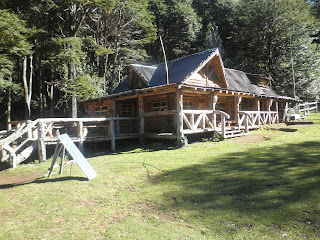The first day's trail ascended westward up the Río Azul valley, passing a couple of refuges before arriving at Retamal (pictured above). The caretaker of this refuge, Adrian, is a friend. We sipped mates and chatted as the mountain chill descended and the last alpenglow left the mountain of Dedo Gordo. Myra had fun guessing what our conversation in Spanish was about, and did a great job, although false cognates from Greek occasionally got in the way. As night fell the refuge looked cozier and cozier, but we had resolved to camp out (avoiding the steep refuge fee). Half of our group stayed warm for the whole night, including me, my lightweight sleeping bag stuffed inside a heavier one with a broken zipper that I found on the farm.
The next day we got off to an Argentine Start--the opposite of an Alpine Start. Even so, the first hour an a half of hiking was in chilly shade on a north slope. By midafternoon we gained open ground and sunshine, with a view up the Río Azul canyon to the west-south-west.
At the foot of Dedo Gordo was the valley pictured below, a graceful arc of lenga forest at the height of its color. These beech-like trees dealt with the thin alpine soil by spreading their roots out wide and growing in a boomerang shape, part of their trunk resting on the ground. Apparently lengas grow well in Scotland, but they made me think of another place I've never been: Korea. Lovely.
To get over the ridge to our next refuge we had to climb straight up a dry stream bed out of the lengas and onto a high scree slope. The wind picked up, small rocks tumbled down and away, and we felt like real mountaineers for a while before gaining the ridge and eating avocado sandwiches.
Down the other side, another gorgeous valley of lengas curved down to the Dedo Gordo refuge. Just after we arrived a couple from Buenos Aires showed up. They were taking their new/old VW camper bus out for a test drive in preparation for taking it up to Mexico. Sweet folks. No caretakers around, we were left to our own devices. No chance we were going to get cold on this night, sleeping on cotton yo mats upstairs with a fire going in the woodstove below. Myra and Jeramy, brother and sister, swapped songs each had written since the last time they saw each other, playing them on Jeramy's backpacking guitar.
Below is the view down into Mallín Ahogado and El Bolsón--our last day's hike down. My knees and my senses were just starting to warm up to the rhythm of the mountains, leaving me with hunger for another outing. Hopefully that will be this coming weekend with Jeramy and Alex--one last autum trek before returning to the northern hemisphere springtime.


















































